
Insights
Featured posts
➔
Why courage is essential for connected leaders
Emily ArmstrongWhat banks can learn from leading retailers
Dustin De Vincentislisten to the translating strategy to execution podcast
Experts from the Alumni team give clarity and confidence to executives navigating the digital age for better business performance and reimagined customer relationships.
Can you have it all when deploying technology and embarking on change?
Yes, if you know how to bridge the gap between staying relevant, delivering on innovation, and listening to the people who matter.
Unlock your full digital potential with our expert guidance and tailored solutions.
Why courage is essential for connected leaders
We asked leaders in Singapore to define the specific emotions that are crucial for their teams to experience. Here's what they had to say.
Why digital transformation is different to an IT Project
What's the difference between Digital Transformation and various IT projects? This article demystifies these concepts and highlights the critical dimensions that fuel innovation, efficiency, and competitive advantage.
Velocity vs. Value
Is Velocity a useful tactic for teams to assess their performance and gauge capacity to complete future work? This article seeks to contextualise velocity within the broader perspective of value delivery and offer alternative metrics and methodologies to determine success.
Agile and UX: Delivering products your customers love
Agile has proven to be a winning approach for product development teams focused on fast sprints and seamless collaboration. But in the rush to deliver, we cannot forget the most important factor of all: The User.
The Truth about Agile
Agile helps organizations become adaptable, customer-centric, and able to embrace change. To thrive in a digital world, organizations should also address key digital dimensions like data and total experience.
How to derisk the upfront investment with your product launch strategy
The only chance your product succeeds is by being clever with the tools and analysis methods available at your disposal.
User-centered design is human design
User-centered design is the practice of designing systems that focus on human experiences. But too often, we forget the challenges of human needs.
Data Fabric vs. Data Mesh
Data Mesh focuses on organizational change and decentralized data handling, while Data Fabric involves a unified technology layer for data management. The piece emphasizes the importance of mindset, team skills, and existing data solutions in crafting a data strategy.











